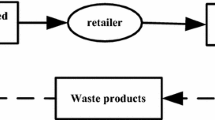Abstract
In a deposit–refund system, not all deposits are refunded; this yields unrefunded deposits that are called unredeemed deposits. If the system is mandatory, it is difficult to decide who should hold these—suppliers, recyclers or government. However, from the perspective of economics, examining the allocation of the unredeemed deposits is not enough. We investigate the optimal design of deposit–refund systems considering the allocation of unredeemed deposits in detail from the economics aspect. The conclusions can be summarized as follows. The refund should be equal to the sum of the following three: (1) the suppliers’ marginal net revenue from collecting and treating used deposit–refund goods, (2) the marginal negative externality, and (3) the deposit multiplied by the share of the unredeemed deposits that the government and the recycler collect from the supplier. The weight for the sum of (2) and (3) is the marginal product for the supplier multiplied by that for the recycler.

Similar content being viewed by others
References
Bohm P (1981) Deposit–refund systems: theory and applications to environmental, conservation and consumer policy. Johns Hopkins University Press, Baltimore
Calcott P, Walls M (2005) Waste, recycling, and “design for environment”: roles for markets and policy instruments. Resour Energy Econ 27:287–305
Container Recycling Institute (2003) The fate of unclaimed or “abandoned” deposits. Available via Container Recycling Institute website. http://www.bottlebill.org/about/unclaimed.htm
Fullerton D, Kinnaman T (1995) Garbage, recycling, and illicit burning or dumping. J Environ Econ Manag 29:78–91
Numata D (2004) Current situation and future tasks of Canada’s beverage container deposit–refund system. Society for environmental economics and policy studies 2004 Japanese annual report, pp 181–194 (in Japanese)
Numata D (2008a) Positive and negative effects of deposit–refund systems: survey of previous economic studies of deposit–refund systems. J Jpn Soc Waste Manag Experts 19(6):353–363 (in Japanese)
Numata D (2008b) How should we mitigate the suppliers’ resistance to deposit–refund systems?. Stud Reg Sci 38(1):163–175 (in Japanese)
Numata D (2009) Economic analysis of deposit–refund systems with measures for mitigating negative impacts on suppliers. Resour Conserv Recycl 53(4):199–207
Numata D (2010) On illegal activities in the California state beverage container deposit system. J Mater Cycles Waste Manag 12(4):314–320
Porter R (2002) The economics of waste. Resources for the Future Press, Washington, DC
Acknowledgments
I am grateful to Professor Jun Iritani of Kobe University who provided valuable inputs on many aspects of this paper. I thank Yuji Fujinaka of Tokyo Institute of Technology and anonymous referees for the valuable comments. I also thank the comments from the participants of Conference of the Economics of Waste and Environment in June 2009 in Fukushima, Japan, including Thomas Kinnaman of Bucknell University. This study was supported by the Grants-in-Aid for Young Scientists (Start-up) 19830008 and is supported by the Grant-in-Aid for Scientific Research (B) 21330056. I greatly appreciate all of them. The responsibility for all errors in this paper is mine.
Author information
Authors and Affiliations
Corresponding author
Appendix: When the return rate is 100%
Appendix: When the return rate is 100%
The Jacobian is u xx − v yy (<0). From the implicit function theorem, the following identities can be set:
and
From comparative statics, the characteristics of x D and y S with respect to p + d, r and Y − T is as follows:
The consumer comparative statics of λ2 with respect to Y − T is 0. Therefore, in the same way as the body, x D and y S are not the functions of Y − T. Equation (14) becomes as follows:
which results in \(Y(I,p,\alpha,d,\beta,\hat{p},s,r,\tau,w). \) Equation (15) becomes as follows:
Equations (16) and (17) are the same as those in the body:
Even though x = y, unredeemed deposits are generated when d is larger than r. In the same way as the body, the indirect utility function becomes as follows:
Equations (19–22) become as follows:
and Walras law holds in the same way as the body. Equation (34) can be seen as the definitional equation of τ. Therefore, we consider the equilibrium as (33) and (35). We substitute (34) into V. As a result, the indirect utility function is as follows:
which is the objective function. In (33), (35), and the objective function, s does not appear, therefore, we delete s from the control variables for the government.
Then, the following equations hold, using (29), (30), (31) and (12):
Therefore,
The Lagrangian becomes as follows:
From this Lagrangian, using the result of the comparative statics above, the first-order conditions of the government behavior are as follows:
Therefore,
These results are almost the same as those in the body, except λ2 + λ3 = −N w . λ2 is the marginal utility of the waste and λ3 is the marginal utility of the excess supply of the deposit–refund goods.
About this article
Cite this article
Numata, D. Optimal design of deposit–refund systems considering allocation of unredeemed deposits. Environ Econ Policy Stud 13, 303–321 (2011). https://doi.org/10.1007/s10018-011-0018-y
Received:
Accepted:
Published:
Issue Date:
DOI: https://doi.org/10.1007/s10018-011-0018-y




